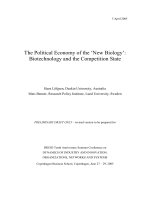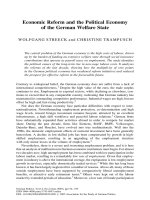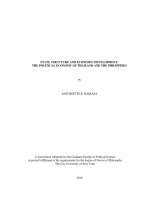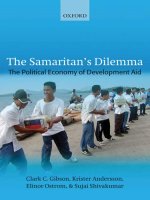paths to a green world the political economy of the global environment
Bạn đang xem bản rút gọn của tài liệu. Xem và tải ngay bản đầy đủ của tài liệu tại đây (1.93 MB, 353 trang )
Paths to a Green World
Paths to a Green World
The Political Economy of the Global Environment
Jennifer Clapp and Peter Dauvergne
The MIT Press
Cambridge, Massachusetts
London, England
© 2005 Massachusetts Institute of Technology
All rights reserved. No part of this book may be reproduced in any form by any
electronic or mechanical means (including photocopying, recording, or informa-
tion storage and retrieval) without permission in writing from the publisher.
MIT Press books may be purchased at special quantity discounts for business
or sales promotional use. For information, please e-mail special_sales@mit-
press.mit.edu or write to Special Sales Department, The MIT Press, 5 Cambridge
Center, Cambridge, MA 02142.
This book was set in Sabon by SNP Best-set Typesetter Ltd., Hong Kong.
Printed and bound in the United States of America.
Library of Congress Cataloging-in-Publication Data
Clapp, Jennifer, 1963–
Paths to a green world : the political economy of the global environment /
Jennifer Clapp and Peter Dauvergne.
p. cm.
ISBN 0-262-03329-1 (alk. paper); 0-262-53271-9 (pbk: alk. paper)
Includes bibliographical references and index.
1. Environmental economics. 2. Environmental policy. 3. Global environ-
mental change. 4. Globalization—Economic aspects. I. Dauvergne, Peter. II.
Title.
HC79.E5C557 2005
333.7—dc22
2004059256
10987654321
For our families
List of Illustrations ix
Preface xi
Acknowledgments xv
Acronyms xvii
1 Peril or Prosperity? Mapping Worldviews of Global Environmental
Change 1
Four Environmental Worldviews 3
Market Liberals 4
Institutionalists 7
Bioenvironmentalists 9
Social Greens 11
Conclusion 16
2 The Ecological Consequences of Globalization 19
What Is Globalization? 19
Globalization and the Global Environment 26
Conclusion 40
3 The Globalization of Environmentalism 45
The Evolution of Global Discourse on Environment and
Development 46
Global Environmental Governance 70
Conclusion 81
4 Economic Growth in a World of Wealth and Poverty 83
Wealth and Poverty for Market Liberals and Institutionalists 83
Critiques: Bioenvironmentalists and Social Greens 100
Conclusion 115
5 Global Trade and the Environment 119
Globalization and Trade 121
Trade’s Impact on the Environment: Three Schools of
Thought 123
Greening of Environmental Trade Agreements? 134
Regional Trade Agreements—Opportunity for Greener
Models? 150
Conclusion 153
6 Global Investment and the Environment 157
Globalization and Transnational Corporations 158
Differential Standards: Pollution Havens, Industrial Flight, Double
Standards? 161
TNCs and Site Practices 169
Greening or Greenwash? 174
TNCs and Global Governance for Investment and the
Environment 179
Conclusion 187
7 Global Financing and the Environment 189
Scope and Trends in International Finance 190
Multilateral Lending: The World Bank and the IMF 196
Multilateral Environmental Aid and the GEF 207
Bilateral Finance: ODA and Export Credit Agencies 210
Private Finance and the Environment 214
Conclusion 216
8 Paths to a Green World? Four Visions for a Healthy Global
Environment 221
Market Liberal Vision 222
Institutionalist Vision 227
Bioenvironmentalist Vision 230
Social Green Vision 234
Clashing Visions? 238
Notes 245
References 273
Index 307
viii Contents
Tables
1.1 Environmental perspectives 14
3.1 Intergovernmental organizations: Voting rules and
revenue sources 74
3.2 Chronology of international environmental cooperation
(summary of major initiatives) 76
5.1 Key GATT/WTO environmental dispute-resolution panels 138
6.1 NAFTA chapter 11 disputes related to the environment 182
Figures
2.1 Life expectancy at birth (high-income and low-income
countries) 29
2.2 World population growth 29
2.3 World population prospects 30
2.4 Global CFC production 32
2.5 World population: AD 1–2000 34
2.6 Global CO
2
emissions from fossil-fuel burning, cement
manufacture, and gas flare 40
4.1 Global GDP 84
4.2 Growth in global GDP per capita 85
4.3 HDI and GDP, 2001, top ten HDI-ranked nations 87
4.4 HDI and GDP, 2001, bottom ten HDI-ranked nations 88
4.5 The economy as a circular flow system 89
4.6 The environmental Kuznets curve 92
4.7 The vicious cycle of poverty and environmental
degradation 96
4.8 The economy as a subsystem of the ecosystem 101
Illustrations
4.9 Entropy hourglass 105
5.1 World exports of goods and services 121
5.2 Growth in the volume of world merchandise exports 122
5.3 World trade (percent of GDP) 122
5.4 Percentage of global trade, by region (imports plus
exports) 123
6.1 World total number of TNCs (parent companies) 159
6.2 World total number of TNC foreign affiliates 159
6.3 World foreign direct investments, net inflows (balance of
payments) 160
7.1 OECD DAC: Official development assistance: ODA as
percentage of OECD GNI 192
7.2 Official development assistance by DAC donor: ODA as
percentage of GNI 192
7.3 OECD DAC: Official development assistance: Total 193
7.4 Debt owed by developing nations 195
7.5 Developing nations: Debt service ratios (percent of
exports of goods and services) 195
7.6 Developing nations: Total debt service paid 196
7.7 Global foreign-exchange market turnover 196
Boxes
2.1 Definitions of globalization 21
3.1 The earth from space 50
3.2 Maurice Strong 55
3.3 Gro Harlem Brundtland 60
3.4 Petra Kelly 62
3.5 Chico Mendes 63
3.6 Wangari Maatthai 63
4.1 Measures of economic development 86
4.2 The Simon-Ehrlich wager 103
4.3 Entropy and ecological economics 104
5.1 Absolute and comparative advantage 124
5.2 GATT article XX (general exceptions clause of the GATT) 136
6.1 ISO 14000 environmental management standards 176
7.1 The developing-country debt crisis 194
x Illustrations
Preface
Paths to a Green World is a highly ambitious book. It is the first to con-
centrate exclusively on the political economy of the global environment,
striving to integrate the debates within the “real world” of global policy
and the “academic world” of theory. It moves well beyond the tradi-
tional academic focus on international agreements and institutions in an
effort to capture the views on politics, economics, and the environment
within the halls of global conferences, on the streets during antiglobal-
ization protests, and in the boardrooms of international agencies, non-
governmental organizations, and industry associations. In doing so, it
investigates the debates over globalization, environmentalism, economic
growth, poverty, consumption, trade, corporate investment, and inter-
national finance. It does so from a variety of angles—economic, politi-
cal, ecological, and social.
The book does not advocate for a particular perspective on how
politics and economics relate to the health of the global environ-
ment. Instead, it offers an original typology of worldviews to classify
the various debates. This typology is, we believe, parsimonious enough
for readers to grasp the key threads with ease, yet nuanced enough to
rouse vigorous debate. The book fills, in our view, a critical gap in the
literature on global environmental change. It meets an immediate
need in the field of global environmental politics, by providing
comprehensive coverage of the political economy of the global
environment. The typology we propose in the book, we hope, will also
meet a much more imposing need: to help scholars, bureaucrats, indus-
trialists, and activists communicate in a common language. This latter
goal is perhaps too ambitious, perhaps even naive. But striving to
facilitate such dialogue is, in our admittedly immodest vision, worth
the risk of seeming arrogant about our ability to traverse disciplinary
boundaries.
We have tried our best to explain the complexities of the political
economy of global environmental change without disciplinary
jargon. Naturally, the book uses terminology; otherwise, it could only
skim the surface of the core debates. Yet, at every turn, we strive
to explain debates and define terms in ways that transcend disciplines.
Our hope is that those from a range of educational backgrounds—
including development studies, economics, environmental studies, geog-
raphy, human ecology, international law, philosophy, political science,
and sociology—can use this book for a big-picture snapshot of the core
debates.
Paths to a Green World would also function well as a university text-
book to introduce the debates on the interface between political economy
and global environmental change. Instructors using this as a textbook
may want to add case studies of particular global environmental prob-
lems. In our own teaching, we add, for example, lectures and readings
on the political economy of climate change, deforestation, food security,
nonrenewable resource extraction, ozone depletion, persistent organic
pollutants, and trade in hazardous waste. But other global environmen-
tal issues—like acid rain, biodiversity loss, desertification, energy use,
overfishing, genetically modified organisms, trade in endangered species,
transboundary pollution, whaling, as well as many others—would work
equally well.
Instructors, too, may want to integrate some literature with more of
a disciplinary focus to expose students to the particular terminology and
research methods that their discipline uses to analyze the political
economy of global environmental change. One of us, for example,
teaches in a department of political science and supplements this book
with readings that reflect the language and debates in the fields of inter-
national relations and global environmental politics. The other teaches
in both environmental and international development studies and sup-
plements the book with readings that reflect the learning of the students
in these programs. It is, we believe, worthwhile to encourage students to
think beyond disciplinary boundaries. Yet often it is just as valuable to
xii Preface
embed some learning within one or two disciplines, because this can
allow for a more erudite analysis of the core questions in a particular
discipline.
We trust all who choose to continue—regardless of the reason for
beginning—will read with the curiosity of a true student, so each of the
worldviews can spring equally to life in the analysis in the rest of the
book.
Preface xiii
We would like to thank all who have inspired us in one way or another
with this book. For invaluable research assistance, special thanks go to
Sam Grey for her tireless work and far-reaching talents. Sharon Goad,
Joshua Gordon, Jeca Glor-Bell, and Sanushka Mudaliar also helped
immeasurably with the research. We are grateful to the Australian
Research Council and the Social Sciences and Humanities Research
Council of Canada for financial support for this research. For perceptive
comments and valuable guidance we would like to thank Herman Daly,
Catherine Dauvergne, Torben Drewes, Derek Hall, Eric Helleiner, and
three anonymous reviewers for The MIT Press. We are grateful to Clay
Morgan for shepherding this book through the publication process. And
we would like to thank our friends and families for their moral support
and patience throughout this project. We accept full responsibility for
any errors or omissions that are bound to arise in a book of this scope,
and would appreciate any feedback from our readers.
AIDS Acquired immune deficiency syndrome
AoA Agreement on Agriculture
APEC Asia Pacific Economic Cooperation
BAN Basel Action Network
BASD The Business Action on Sustainable Development
BECC Border Environmental Cooperation Committee
BIS Bank for International Settlements
CBD Convention on Biological Diversity
CDIC Canadian Development Investment Corporation
CEC Commission on Environmental Cooperation
CEO Chief executive officer
CFCs Chlorofluorocarbons
CIDA Canadian International Development Agency
CIS Commonwealth of Independent States
CITES Convention on International Trade in Endangered Species
of Wild Flora and Fauna
CO
2
Carbon dioxide
COP Conference of the Parties
CPRs Common property regimes
CSD UN Commission on Sustainable Development
CSR Corporate social responsibility
CTE Committee on Trade and Environment
DAC OECD Development Assistance Committee
DCSD Danish Committee on Scientific Dishonesty
DDT Dichlorodiphenyltrichloroethane
DPRK Democratic People’s Republic of Korea
ECAs Export credit agencies
ECGD Export Credit Guarantee Department (UK)
ECOSOC UN Economic and Social Council
EFIC Australian Export Finance and Insurance Corporation
EIA Energy Information Administration
EKC Environmental Kuznets curve
EPA Environmental Protection Agency (U.S.)
ESCAP UN Economic and Social Commission for Asia and the
Pacific
EU European Union
FAO Food and Agriculture Organization
FCCC UN Framework Convention on Climate Change
FDA Food and Drug Administration (U.S.)
FDI Foreign direct investment
FOE Friends of the Earth
FOEI Friends of the Earth International
FSC Forest Stewardship Council
G-77 Group of 77
GAST General Agreement on Sustainable Trade
GATS General Agreement on Trade in Services
GATT General Agreement on Tariffs and Trade
GDP Gross domestic product
GEF Global Environment Facility
GEMI Global Environmental Management Initiative
GEO Global Environment Outlook
GMOs Genetically modified organisms
GNI Gross national income
GNP Gross national product
GPI Genuine progress indicator
HDI Human development index
xviii Acronyms
HIPC Heavily indebted poor countries
HIV Human immunodeficiency virus
IBRD International Bank for Reconstruction and Development
ICC International Chamber of Commerce
ICSID International Center for the Settlement of Investment
Disputes
IDA International Development Association
IFC International Finance Corporation
IFG International Forum on Globalization
IIC International Insolvency Court
IISD International Institute for Sustainable Development
IMF International Monetary Fund
IPCC Intergovernmental Panel on Climate Change
ISEW Index of sustainable economic welfare
ISO International Organization for Standardization
ITU International Telecommunications Union
IUCN International Union for Conservation of Nature and
Natural Resources
JBIC Japan Bank for International Cooperation
LETS Local exchange trading systems
LPI Living planet index
MAI Multilateral Agreement on Investment
MARPOL Convention for the Prevention of Pollution by Ships
MEA Multilateral Environmental Agreement
MFN Most favored nation
MIGA Multilateral Investment Guarantee Agency
MMPA Marine Mammal Protection Act (U.S.)
NAAEC North American Agreement on Environmental Cooperation
NAFTA North American Free Trade Agreement
NASA National Aeronautics and Space Administration
NGO Nongovernmental organization
NIEO New International Economic Order
Acronyms xix
ODA Official Development Assistance
OECD Organization for Economic Cooperation and Development
OPEC Organization of Petroleum Exporting Countries
OPIC Overseas Private Investment Corporation (U.S.)
PCBs Polychlorinated biphenyls
POPs Persistent organic pollutants
PPMs Production and processing methods
PPP Polluter pays principle
PVC Polyvinyl chloride
SAL Structural adjustment loan
SAP Structural adjustment program
SPS Agreement on the Application of Sanitary and Phytosani-
tary Measures
SUV Sports utility vehicle
TBT Agreement on Technical Barriers to Trade
TNC Transnational corporation
TRIPS Trade Related Intellectual Property Rights Agreement
TWN Third World Network
UK United Kingdom
UN United Nations
UNCED UN Conference on Environment and Development
UNCTAD UN Commission on Trade and Development
UNCTC UN Center on Transnational Corporations
UNDP UN Development Programme
UNEP UN Environment Programme
UNFPA UN Fund for Population Activities
U.S. United States
USAID U.S. Agency for International Development
WBCSD World Business Council for Sustainable Development
WCED World Commission on Environment and Development
WDI World Development Indicators
WEO World Environment Organization
xx Acronyms
WHO World Health Organization
WICE World Industry Council on the Environment
WLO World Localization Organization
WRI World Resources Institute
WWF WWF Network (formerly World Wildlife Fund/World Wide
Fund for Nature)
WWW World Wide Web
Acronyms xxi









